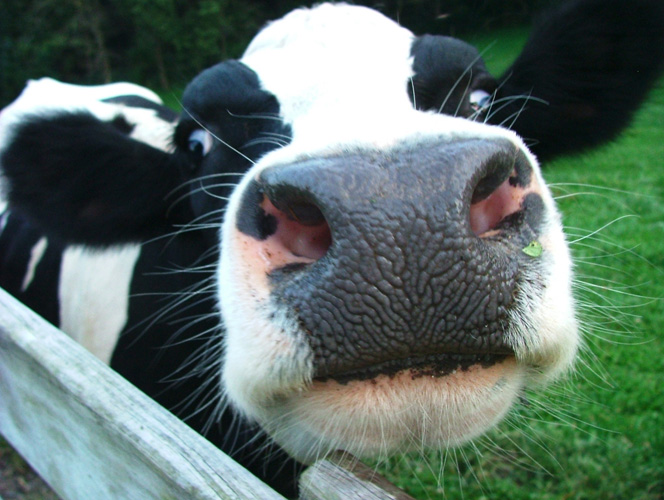
First you blame me for global warming cause I get gas. Now you tell me there's crap in your water? (Photo by Gabrielle Gagne)
California’s Central Valley is probably the best example of the past success and imminent failure of industrial agriculture. The signs of the scope and proximity of the failure are accumulating fast, but while the past success has many wealthy fathers, the coming failure is an orphan.
If the plains of the upper Midwest are America’s breadbasket, the Central Valley is its vegetable hamper. From its 52-thousand square miles, the Valley ships some 250 crops to a grateful nation that responds with about $17 billion in hard cash per year. The marvel of it all is that these crops include such thirsty plants as lettuce, tomatoes and melons, and they are being grown on very arid land — the southern half of the valley is, technically, a desert, and the north nearly so, especially in the recent, years-long drought. Behold the power and the wealth of industrial agriculture.
But as industry increases the scale of its enterprises for the resulting economies, it concentrates the risk of its enterprises. The industrialists take the profits as they come in, the payoff of the risk is delayed until it accumulates to a catastrophic size to be borne by all.
Central Valley growers require water, which they once obtained from the watersheds of the San Joaquin and Sacramento Rivers. When that supply proved too puny for their dreams they built an enormous system of canals to funnel water from Northern California (it always rains in Northern California) into their desert. Now that climate change has reduced rainfall and snowfall in the region, shrinking the snow fields and reservoirs that feed the rivers and canals (to such a degree that some of the canals are threatening to dry up completely), the growers are turning more heavily to the underground aquifer.
Recent advances in satellite imagery have made visible what was previously suspected: the growers are plundering the aquifer. According to a study presented to the American Geophysical Union in 2009, in the previous six years the growers pumped nearly five cubic miles of water from beneath their desert to put on their lettuce, dropping the water table an average of 9.5 inches per year in the Valley and an astonishing 19.75 inches per year in the San Joaquin basin.
A more recent indicator of the industrialists’ contempt for the world comes in a report this month from Food and Water Watch on the serious threat to the diminishing water supply posed by milk factories. (News stories about the report continue to refer to these monstrosities as dairy farms, which is like confusing a head cold with a brain tumor. The report itself uses the correct term, industrial dairies.) Virtually unknown 20 years ago, there are now nearly 1,500 milk factories in the Valley, each housing over a thousand mature cows, which all together emit five times the amount of fecal matter generated by the people of the city of Los Angeles.
No regulations at all were imposed on this sea of sewage until four years ago, when, according to the report, minor restrictions and reporting requirements were put in place and have been largely ignored since. Thanks to the milk industry and its wholly-owned politicians, the report says:
- 60 percent of the dairies have groundwater on their property that is contaminated with nitrates above the drinking water standard.
- 40 percent of these dairies (550 facilities) have nitrate levels at least twice the drinking water standard.
- 85 percent of dairies in the Valley are located within 300 feet of an off-site domestic well (someone else’s drinking water source), raising concerns that other Valley residents’ water is contaminated.
- Under California law, facilities that contribute to a violation of a water quality standard are subject to cleanup and abatement orders and can be fined. There have been no dairies fined for contributing to high nitrate levels in groundwater in the Valley and no cleanup and abatement orders issued.
- 71 dairies failed to turn in part or all of the documentation required by the new regulations in the first year after they were implemented, but none of these dairies was fined.
Here’s the irony. The stuff that is making the water undrinkable for the human population — the compounds of nitrogen — is exactly what the growers are buying by the millions of tons to have synthesized by fossil fuels and spread on their fields. If the growers put the nitrates on growing crops, they would not go into the water supply.
But let’s get real. That would require a modicum of common sense and of concern for the web of life. The reality is that with more crap going into less water, without any interest on the part of government, the return of the Central Valley to its former status as a desert is surely not far off.
[ UPDATE: Oh, wait. Silly to say the government is not interested in such problems. In Florida (” We pledge allegiance to Florida, one state, under Big Agriculture, unsalvageable….) a state senator (of course he’s a Republican) has introduced a bill that would make it a first-degree felony to photograph a farm without first obtaining written permission from the owner. A farm is defined as any land “cultivated for the purpose of agricultural production, the raising and breeding of domestic animals or the storage of a commodity.” According to the Florida Tribune (I am not making this up) the bill was inspired by the spread of undercover videos revealing the barbarian practices of industrial concentration camps for animals. One farmer said the bill is needed to protect the property rights of farmers and the “intellectual property” involving farm operations.]